
How Do Drum Brakes Work?
Unlike disc brakes, which use rotating discs with calipers and pads and are generally considered more effective and safer, drum brakes use a rotating cylinder to slow a vehicle with brake shoes.
When the drivers press the brake pedals, the brake fluid generates hydraulic pressure and presses the brake shoe against the rotating drum. The shoes are made of friction-causing materials, which ultimately slows down the vehicle.
Over the past few decades, disc brakes have outpaced drum brakes as it is the stopping force of choice for most new automakers. It is still possibles to buy a new car with drum brakes, but they are generally only used on the rear wheels with disc brakes on the front wheels.
Working of Drum Brakes:
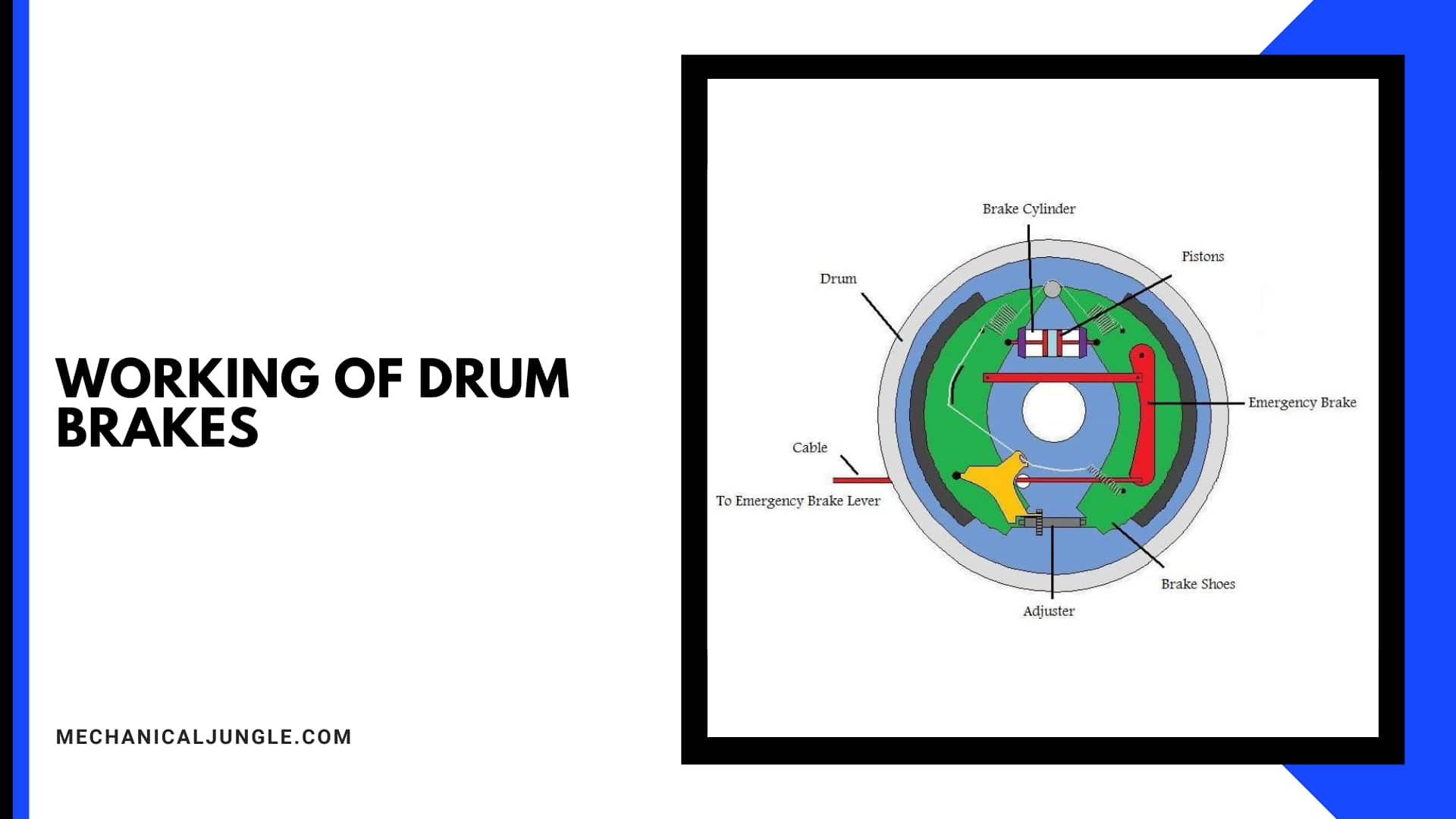
Forces of friction that come into action make the shoe fit around the drum. The latter action is prevented by pins and cams.
Hence the pin is called the anchorage pin. The magnitude of the friction forces, multiplied by the radius of the drum, gives the torque to stop the drum, that is, the breaking torque.
The entire mechanical linkage between the brake paddles and the shoes operates to transmit and multiply the pedal force to the brake shoes. The paddle force through the leverage produces an effective braking force against the drum.
A retreating spring is placed between the breaking shoes. These retracting springs pull the shoe away from the drum when the cam is turned and moved to the release position.
This system in which shoes are placed to rub against the inner surface of the brake drum is called the internal extension brake. In this system, each part of the linkages must be free to move. The joints must be properly lubricated to reduces friction & wear.
Otherwise, uncertain and uneven braking action may result. As the brake pedals are pressed, it compresses the fluid in the master cylinder & allows the piston of the wheel cylinder to extend outward.
The external force of the piston of the wheel cylinder forces the brake shoe outward against the brake drum. As the brake shoe linings touch the inner surface of the drum, & due to friction generated between the brake shoe & the drum, the wheel speed decreases, and the vehicle stops.
As the forces are removed from the brake paddle, the retractor springs pull the brake shoe inward, and contact between the friction lining and the drum is eliminated. Now preparations are made to apply the brakes again.
Type of Drum Brakes:

Brake shoes fitted with brake lining (friction material) that press against the drum from the inside (drum and stop) are set inside the drum to produce braking force. With this system, friction is generated by pressings the brake lining against the surfaces inside the drum.
This friction converts kinetic energy into thermals energy. Drum rotation helps suppress the shoe and lining against the drum, offering better braking force than disc brakes.
On the others hand, it is very important to design components so that heat is efficiently dissipated in the atmosphere by thermal energy.
There are three types of drum brake, depending on how the brake shoes are pressed on the drum; Leading/trailing shoe type, twin leading shoe type, and duo-servo type.
1. The Structure
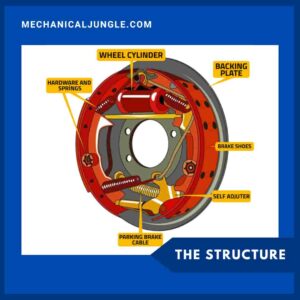
The drum brake is a brake system with a brake drum (rotor) that rotates with the wheels. Inside each drum are fitted shoes with brake linings (friction material). Pistons (pressure mechanisms) press from inside the drum to generate braking force, thus making it possible to stop and stop the vehicle.
2. How Drum Brakes Work
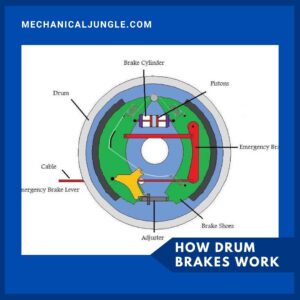
When the driver steps on the brake pedals, the powers are amplified by the brake booster (servo system) and converted to hydraulic pressure (oil pressure) by the master cylinder. The pressure reaches the brake on the wheels through a tubing filled with brake oil (brake fluid).
The distributed pressure pushes the piston on the brakes of the four wheels. Piston brake drums, which are friction materials, press against the inner surfaces of the brake drum that rotate with the wheels.
The linings are pressed onto rotating drums, which in turn lower the wheels, causing the vehicle to slow down and stop the vehicle.
#3. Leading / Trailing Shoe
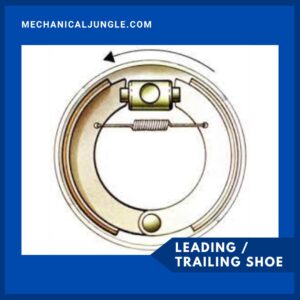
“Leadings (or primary) shoe” is a term referring to a shoe that moves in the direction of rotation when pressed towards the drum.
The second shoe is called the “trailing (secondary) shoe.” The leading shoes are pressed in the same directions as the rotation of the drum, and this rotation helps to press the over-pressured shoe against the drum for stronger braking force.
This is called the self-boosting effect that realizes the powerful braking forces of the drum brake. Structurally, it has a piston with a wheel cylinder housing with which hydraulic pressure is generated to push two shoes against the inner surface of the drum.
In a way, the two shoe function; they both become either a running shoe or a leading shoe, depending on whether the vehicles are travelings forward or backward. Drum brakes generate a constant braking force whether the vehicle travels forward or backward.
This is because drum brakes produce the same braking force in both directions. Typically, this type is used for the rear brake of passenger cars.
#4. Twin Leading Shoe
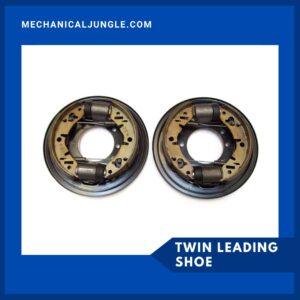
Such drum brakes have a two-wheel cylinder and two leading shoes. Each wheel cylinder pressure on one shoe so that both shoes act as a lead when the vehicle is moving, providing better braking force.
Each piston placed in the wheel cylinder is displaced in one direction, so when the vehicle is in reverse, the two shoes act as a rear tread. These types are mainly used for front brakes in small-to-medium-sized trucks.
The type of dual twin leading shoe consists of pistons that migrate in both directions, making it possible for both shoes to act as the leading regardless of the direction of travel. This type is mainly used for rear brakes of small-to-medium size trucks.
Advantages of Drum Brake System:
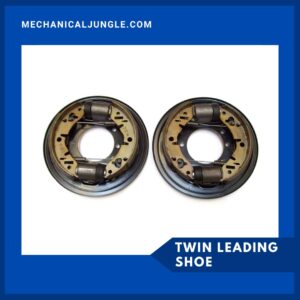
Here, the different Advantages of a drum brake system are as follows
- Simple design.
- Low maintenance cost.
- Comparatively long life.
- Lower part.
- Easy and cheap to manufacture.
Disadvantages of Drum Brake System:
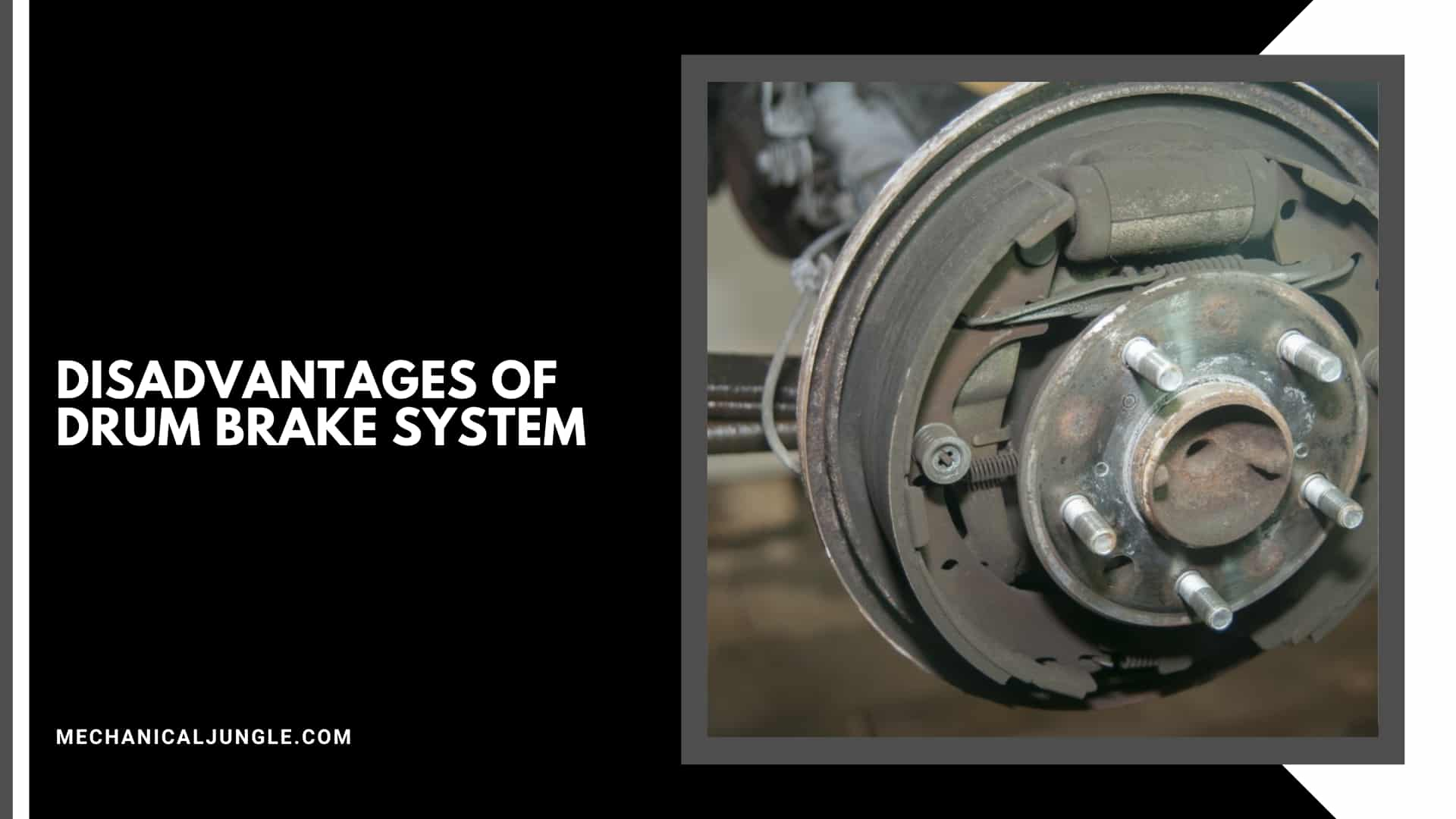
Here, the different Disadvantages of a drum brake system are as follows
- Lower braking force than disc.
- The brake ‘fades’ when the driver applies them for a long time.
- The breaking grip is reduced significantly when wet.
- Non-asbestos lining captures moisture; Which caused sudden brakes.
- A brake shoe lining made of asbestos is harmful to humans.
FAQ: Drum Brakes
What Are Drum Brakes?
Drum brakes are a type of braking system that uses brake shoes to press against a rotating drum, creating friction to slow down or stop a vehicle.
How Do Drum Brakes Work?
When the driver presses the brake pedal, brake fluid generates hydraulic pressure, causing the brake shoes to press against the rotating drum. The friction material on the shoes slows down the vehicle.
What Components Make Up a Drum Brake System?
Key components of a drum brake system include the brake drum, brake shoes, friction material (brake lining), pistons, wheel cylinder, and retracting springs.
What Is the Role of the Brake Shoe in Drum Brakes?
The brake shoe is a component that presses against the drum to create friction, which slows down the vehicle.
Why Are Disc Brakes More Common Than Drum Brakes in Modern Vehicles?
Disc brakes are generally considered more effective and safer than drum brakes. They provide better stopping power and heat dissipation, which is why they are preferred for front wheels and sometimes all four wheels in modern vehicles.
Can You Still Find Drum Brakes in New Cars?
Yes, drum brakes are still used in some new cars, typically on the rear wheels, while the front wheels are equipped with disc brakes.
What Is the Leading/trailing Shoe Type of Drum Brake?
In the leading/trailing shoe type, the leading shoe moves in the direction of rotation when pressed against the drum, providing stronger braking force due to the self-boosting effect. The trailing shoe moves in the opposite direction.
What Is the Twin Leading Shoe Type of Drum Brake?
The twin leading shoe type has two-wheel cylinders and two leading shoes, each providing braking force when the vehicle moves forward. Both shoes act as leading shoes, offering better braking performance.
What Is the Duo-Servo Type of Drum Brake?
The duo-servo type has a self-energizing effect, where both shoes can act as leading shoes depending on the vehicle’s direction of travel. This type is often used in rear brakes of small-to-medium-sized trucks.
What Are the Advantages of Drum Brakes?
Advantages include a simple design, low maintenance cost, long life, and ease of manufacturing.
What Are the Disadvantages of Drum Brakes?
Disadvantages include lower braking force compared to disc brakes, brake fade during prolonged use, reduced braking effectiveness when wet, and potential health hazards from asbestos brake linings.
How Does the Braking Force of Drum Brakes Compare in Different Directions?
Drum brakes provide consistent braking force regardless of whether the vehicle is moving forward or backward, thanks to the design of the shoes and the self-energizing effect.
What Maintenance Is Required for Drum Brakes?
Drum brakes require regular inspections to ensure all components are free to move and properly lubricated. The brake shoes and linings should also be checked for wear and replaced as needed.
Why Is Proper Lubrication Important in Drum Brakes?
Proper lubrication reduces friction and wear between the mechanical linkages, ensuring smooth and effective braking action.
How Does Heat Dissipation Affect Drum Brakes?
Efficient heat dissipation is crucial for drum brakes to prevent brake fade and maintain braking performance, especially during extended braking periods.
Are Drum Brakes Effective in Wet Conditions?
Drum brakes can lose effectiveness when wet, as moisture can reduce friction between the brake shoes and the drum.
What Are the Health Concerns Associated with Asbestos Brake Linings?
Asbestos brake linings can release harmful fibers when worn, posing a health risk to humans. Non-asbestos alternatives are now commonly used to mitigate this risk.
How Do Retracting Springs Function in Drum Brakes?
Retracting springs pull the brake shoes away from the drum when the brake pedal is released, eliminating contact between the friction lining and the drum and preparing the system for the next braking application.
Can Drum Brakes Be Used on All Types of Vehicles?
While drum brakes can be used on various types of vehicles, they are more commonly found on the rear wheels of passenger cars and the rear brakes of small-to-medium-sized trucks. Disc brakes are generally preferred for front wheels due to their superior performance.
What Factors Contribute to the Braking Torque in Drum Brakes?
The braking torque is determined by the friction forces between the brake shoes and the drum, multiplied by the radius of the drum. This torque effectively slows down or stops the drum’s rotation, thus decelerating the vehicle.

